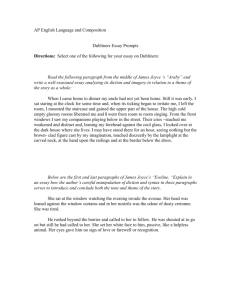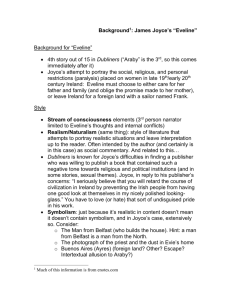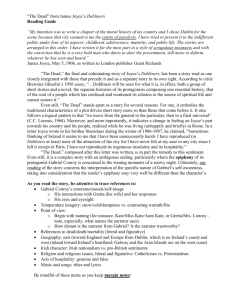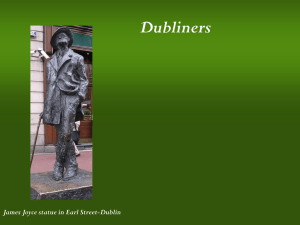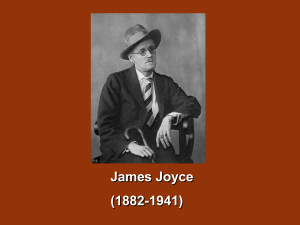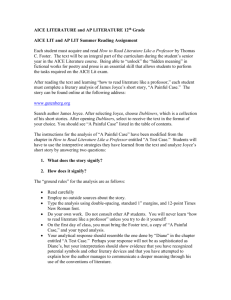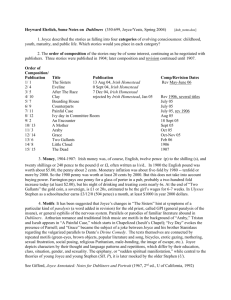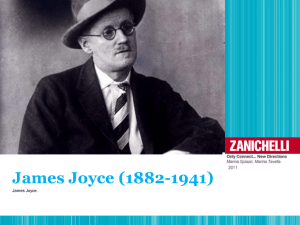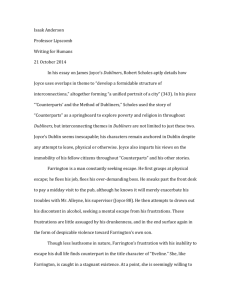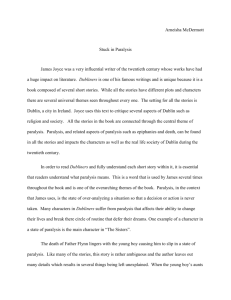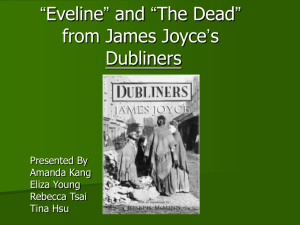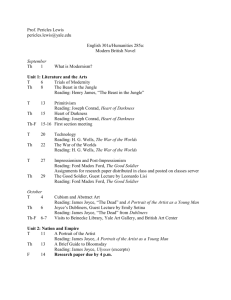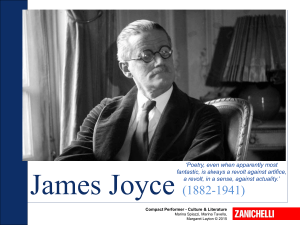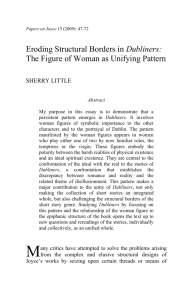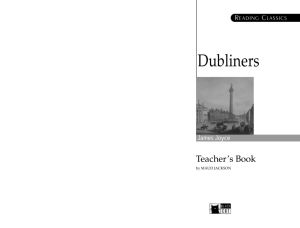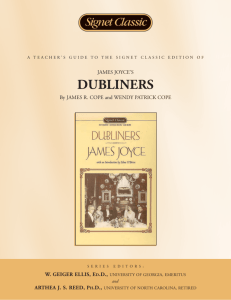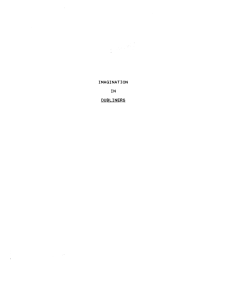lesson on james joyce, dubliners and eveline
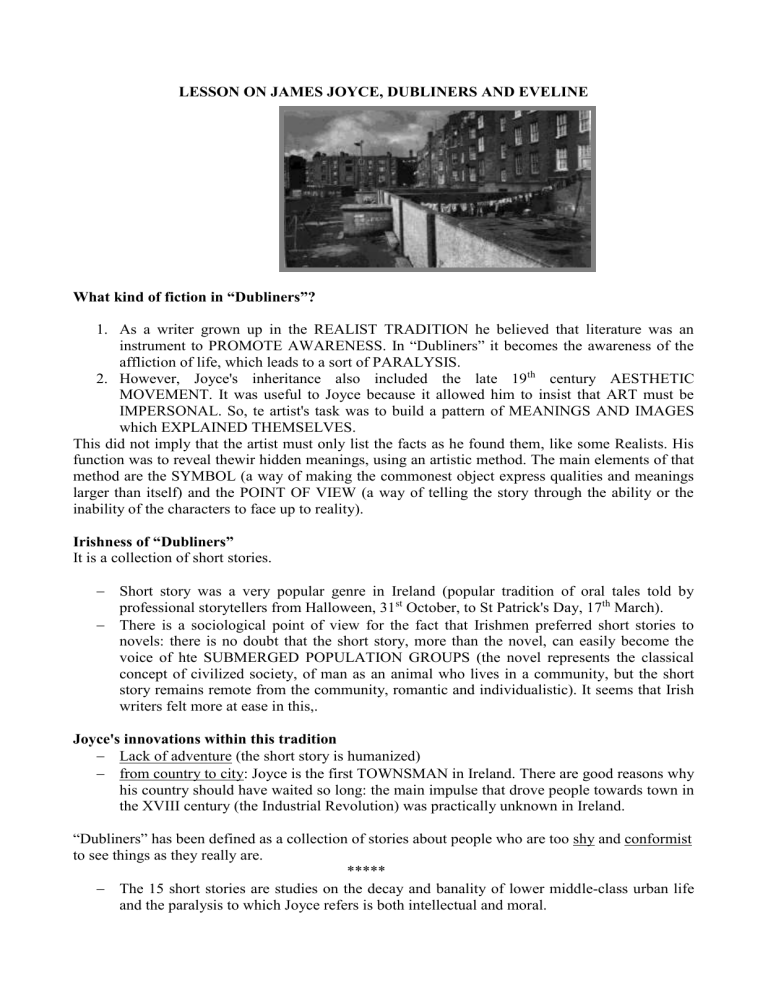
LESSON ON JAMES JOYCE, DUBLINERS AND EVELINE
What kind of fiction in “Dubliners”?
1.
As a writer grown up in the REALIST TRADITION he believed that literature was an instrument to PROMOTE AWARENESS. In “Dubliners” it becomes the awareness of the affliction of life, which leads to a sort of PARALYSIS.
2.
However, Joyce's inheritance also included the late 19 th
century AESTHETIC
MOVEMENT. It was useful to Joyce because it allowed him to insist that ART must be
IMPERSONAL. So, te artist's task was to build a pattern of MEANINGS AND IMAGES which EXPLAINED THEMSELVES.
This did not imply that the artist must only list the facts as he found them, like some Realists. His function was to reveal thewir hidden meanings, using an artistic method. The main elements of that method are the SYMBOL (a way of making the commonest object express qualities and meanings larger than itself) and the POINT OF VIEW (a way of telling the story through the ability or the inability of the characters to face up to reality).
Irishness of “Dubliners”
It is a collection of short stories.
Short story was a very popular genre in Ireland (popular tradition of oral tales told by professional storytellers from Halloween, 31 st
October, to St Patrick's Day, 17 th
March).
There is a sociological point of view for the fact that Irishmen preferred short stories to novels: there is no doubt that the short story, more than the novel, can easily become the voice of hte SUBMERGED POPULATION GROUPS (the novel represents the classical concept of civilized society, of man as an animal who lives in a community, but the short story remains remote from the community, romantic and individualistic). It seems that Irish writers felt more at ease in this,.
Joyce's innovations within this tradition
Lack of adventure (the short story is humanized)
from country to city: Joyce is the first TOWNSMAN in Ireland. There are good reasons why his country should have waited so long: the main impulse that drove people towards town in the XVIII century (the Industrial Revolution) was practically unknown in Ireland.
“Dubliners” has been defined as a collection of stories about people who are too shy and conformist to see things as they really are.
*****
The 15 short stories are studies on the decay and banality of lower middle-class urban life and the paralysis to which Joyce refers is both intellectual and moral.
The characters who appear in the story lead uneventful and frustrated lives. The fact that there is very little action points again to the paralysis and monotony of life in a modern city.
Though there is little external action and the stories seem simply to be realistic and objective descriptions of everyday life, they are psychologically eventful. The psychological action often takes the form of an EPIPHANY in which a commonplace action or object brings a character an unexpected revelation of truth and a deep understanding of life.
EPIPHANY: it is by means of apparently trivial unimportant details that we can catch every external revelation of the deep truth about a person or situation and, in general, of the secret meaning of life.
“EVELINE”
(Docks on the river Liffey)
In the structure of “Dubliners” this is the first story of the sequence about adolescence.
Eveline represents the woman-victim.
Escape and elopment fail, except for the very strong (and Eveline lacks strength): dreams and memories do not help to build a future; innocence can be synonymous with stupidity, and the same is true of uncritical attachment to moral or religious values.
However, nowhere more than in this study of the paralysis of action does Joyce lay so much stress on the smothering influence of environment, social and economic conditions.
Hence, the choice of certain words and the repetitions of certain phrases:
evening invading the avenue
odour of dusty cretonne (twice)
tired, dead, broken
evening deepening
closed, dark room
melancholy air
nausea, passive, helpless
as well as the insistance on the power of habits among those who don't have the means of shaking them off ( what for?
) by means of the use of negatives or semi-negatives of resignation:
they seemed to have been rather happy then. Her father was not so bad then. She did not find it a wholly undesirable life and of the quation marks of hesitation:
was that wise?
*****
The theme of “Dubliners” is PARALYSIS; paralysis of action in Eveline, and failure.
The 15 short stories describe the historical, social and psychological forces that hindered the life of
Dubliners and led them to a moral and psychological paralysis. The paralysis Joyce illustrates is both physical and moral and it is caused by religion, politics and culture.
Another theme is ESCAPE, which is the opposite of paralysis. Characters experience a sense of imprisonment, but they all fail; they don't manage to escape.
The story is told from the point of view of a character. The interior monologue is in the form of indirect thought.
AWARENESS is the moral centre of Dubliners: reaching awareness is the climax of the stories, and knowing oneself is a very important element of morality, if not morality itself.
Photocopy number 8
